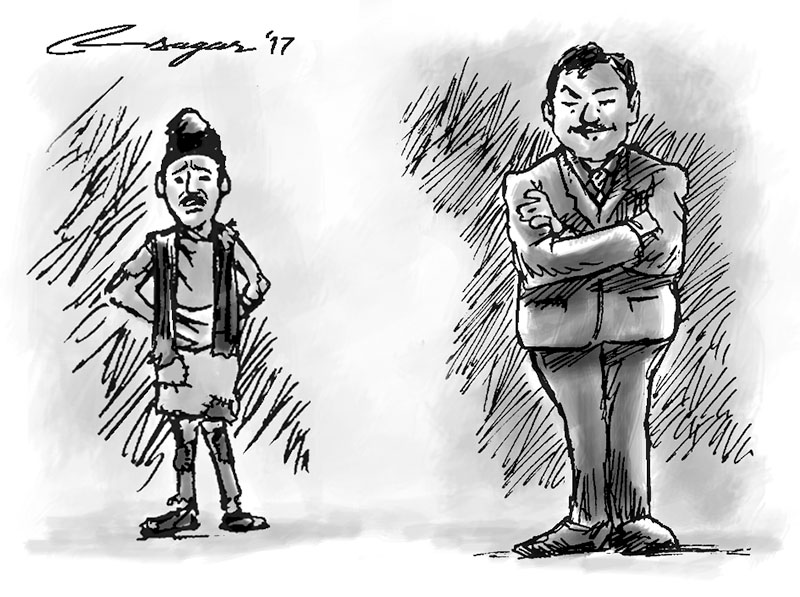Rise in global inequality: Lessons for Nepal
About 65 percent of the farmers own just 15 percent of land and only 5 percent of the total farmers have access to institutional credit facilities. More than 36 percent of the households face food deficit in a year
The revival of intense debate on inequality issues in the aftermath of the great financial crisis of 2008 and its contagion proves that over income concentration was largely responsible for this. The inequality, however, has worsened further as the Oxfam Briefing Paper of January 2017 indicates. The Oxfam paper reveals that now the richest 1 per cent owns more wealth than the rest of the globe. The huge body of empirical research points out that, along with intensification in globalization and financialization, the rate of profit of financial oligarchic and transnational corporations has heightened sharply over the years. Lately, apart from gigantic banks and other corporate houses, the supply chains which capture almost 80 percent of the global trade are extracting profits phenomenally by exploiting consumers including small producers of the developing countries. Studies point to the extent of systemic takeovers of the state powers by the financial oligarchic and transnational corporations by means of their mighty financial power.
Conversely, along with low and stagnating wages of the unskilled workers, including their massive displacement through job polarization and increased capital intensive or high technology based production system, the share of wage income has reduced phenomenally. Such a route has been the principal means of income concentration or inequality, among others. The depressed demand, higher unemployment, falling commodity prices, stagnating trends in real sector and fragile recoveries in most of the economies are the outcome of these. Such paradoxes driven inequalities are now aggravating social contradictions and crisis.
As a result, anti-globalization including anti-migration campaigns, revolt against mainstream political forces, nationalist sentiments and tendencies of protectionism have mounted across the capitalist countries and many other parts. Interestingly, with increased unpopularity of many mainstream political forces after abandoning either the principles of welfare capitalism or progressive agenda, extreme rightist forces through rhetoric and populism are now attempting to fill up the space by exploiting people’s anger and frustration.
The context of Nepal is more unique and illustrative. Systemic exclusions and discrimination of various forms perpetuating inequalities in society were instrumental, to a greater extent, for the long struggle of the people and their sacrifices leading to sweeping political changes in 2006. Since then, inclusion and equality have been the buzzwords in Nepal, and, importantly, they form the cornerstone in the new Constitution. Therefore, inequality and factors affecting the potential trend become important to gauge the compatibilities.
Unlike its own mystifying practices of using consumption based inequality in policy documents, the National Planning Commission in the Sustainable Development Goals (SDGs) exercise has rightly estimated and used income an inequality ratio which is 0.46. This is high compared to the consumption based inequality of around 0.33 reported in the Living Standard Survey findings of 2011. A more robust estimate further shows that income inequality is in the neighborhood of 0.51. This clearly indicates that inequality is high in Nepal in international comparisons. Global Human Development Reports (HDRs) point out that if the inequality factor is adjusted, the value of Human Development index (HDI) is reduced by one third. A large variation in HDI in terms of gender, castes, districts and regions is reported by the Nepal HDR of 2014. Worryingly, taking various factors affecting the likely trend together reveals that, unless checked, inequality is bound to manifest more pervasively in the days to come.
Despite resources based potentialities, low but jobless growth, very low productivity, increased informalization, intensified labor market vulnerability and mounting youth unemployment are the major features of the Nepalese economy. Resource draining government expenditure pattern amidst a highly regressive tax system, trade and finance induced consumption for quicker higher margins or profits and unproductive and non-tradable areas focused private investment centering mainly in the urban centers have contributed to such a phenomenon.
So far, the services sector is the main rescuer of the economy thanks to the massive inflows of remittances amidst continued stagnation in the agriculture sector and deceleration in industry. About 65 percent of the farmers own just 15 percent of land and only 5 percent of the total farmers have access to institutional credit facilities. More than 36 percent of the households face food deficit in a year. A phenomenal rise in both food and non-food imports is taking place with erosion of the productive base of the economy from the grassroots. Such a phenomenon has intensified in the post neo-liberal era.
The inequality is embedded in policies, programs, institutional setups and arrangements structurally. Instead of rhetoric, obligatory and accountable systems have to be strengthened with priority before it becomes too late. The combined strategy of high quality growth enhancing, social protection enlarging and disadvantaged benefiting disproportionately will be necessary following an overhauling approach to ensure growth with equity in a sustained way.






